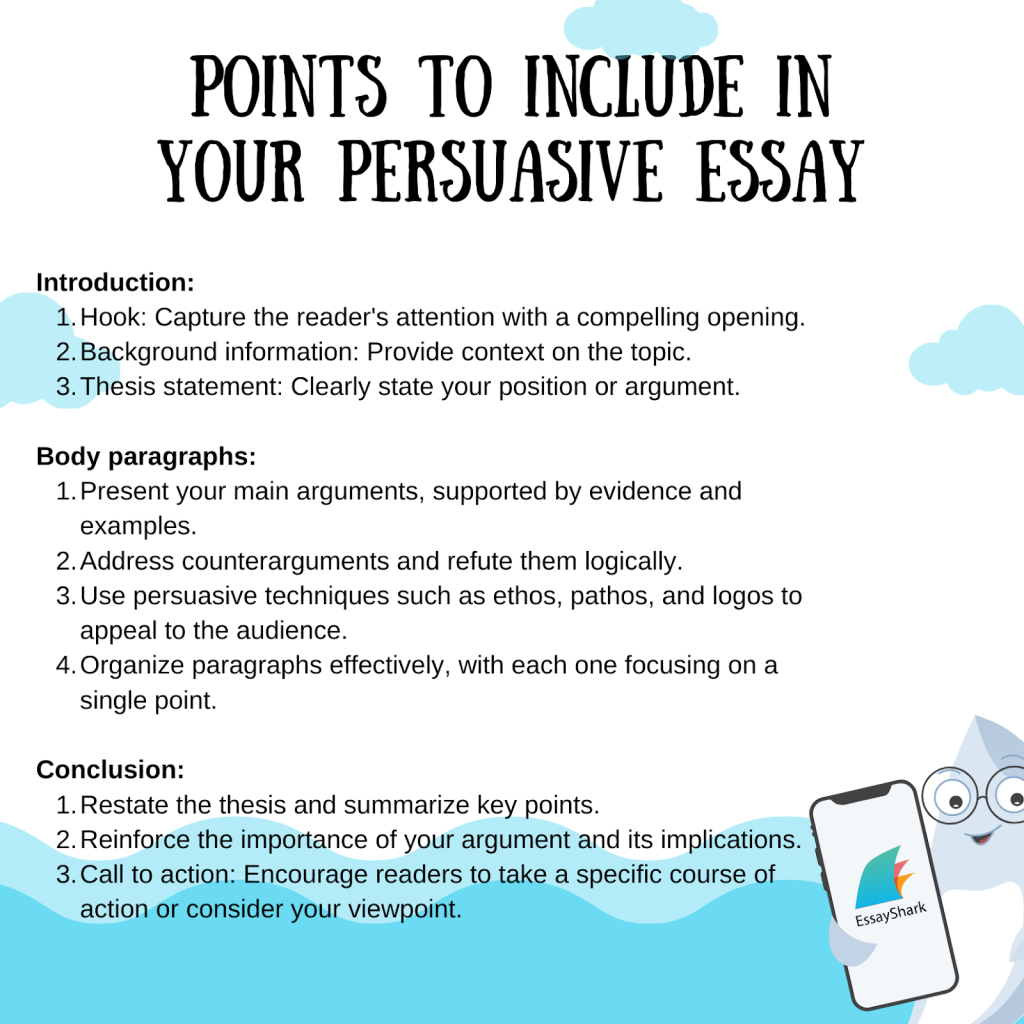Table of Contents
What is a persuasive essay? How to make a good persuasive essay? These questions are of concern to many students, and often, students receive assignments without understanding exactly what they’re meant to do. To write a first-class persuasive essay, you need to understand exactly all the nuances of writing this type of academic paper, including such elements as the structure, formatting, and presentation of the central thesis.
But if you’re feeling overwhelmed, there’s no need to despair; in this guide, we’ll reveal everything you need to know about this type of essay to help you write a high-quality paper that will ‘wow’ your instructor. Whether you are writing an essay for school or college, our complete guide can help you overcome all the challenges and create a top-notch essay by following our step-by-step instructions.
What Is a Persuasive Essay
With evidence to back it up, a persuasive essay provides an argument on a particular subject or theme. Persuasive texts serve multiple purposes. You may want to persuade someone to change their mind on a specific issue or to promote a particular product or service. Using a combination of emotive language and, in certain instances, imagery backed by evidence, along with incorporating well laid out arguments and opinions from others can help you produce an excellent persuasive essay
An argumentative or persuasive essay aims to persuade the reader to agree with the writer’s point of view on a specific topic. A compelling argument that persuades the reader to agree with the student’s viewpoint or perform the desired action benefits when the student draws on various persuasive strategies.
Steps to Write a Persuasive Essay
Prepare for Writing Your Persuasive Essay
The first step in writing an academic paper is preparation. First, it’s helpful to tune into the appropriate mindset to ensure maximum productivity. Adapting writing rituals will help with this, for example, going to your favorite location for being creative or drinking a cup of your favorite coffee before starting to work.
Maximize your workspace so that it brings you joy to work there. For example, some people prefer writing with a mechanical keyboard because they feel a certain tactile or aesthetic pleasure from typing. Listening to music that you like that lends itself to focusing can help inspire you. Sound-isolating headphones can also help you stay focused by reducing distractions. Many people use focus apps to help them concentrate. So that’s step one. When your ideal working-environment conditions have been created, working on your top-notch persuasive essay will be far easier and more enjoyable.
Conduct Advanced Academic Research
The next stage in writing an academic paper is advanced academic research. Most essays should be based on the central thesis that you’ve chosen. Your task then is to convince the reader of the correctness of your thesis using an argument with links to credible sources.
Study and analyze the topic comprehensively at the research stage. Compile a list of references supporting specific arguments in your paper. It is considered good practice to begin creating an outline of your essay during research. This approach will allow you to start thinking about the structure of your paper in advance and focus your research.
In the research process, it’s crucial to distinguish reliable sources of information from dubious ones. To save time and quickly eliminate most unreliable sources of information, we recommend using search tools such as Google Scholar. Proper research is considered the most essential step among all common steps to write a persuasive essay. Once you’ve done all your research, it’s time to finish that outline you started.
Outline Your Essay
How do I start a persuasive essay? A good outline can be your best friend. Many students underestimate the usefulness of outlining and prefer to spend only a few minutes on this stage. However, a good outline can make the difference between a poor essay and a good one or a good one and an excellent one. The outline is your plan for the paper. Think through the structure and main theses. Evenly distribute key arguments and theses between chapters. By spending those extra minutes on the outline before writing your first draft, you might actually save yourself hours in the writing and editing stages.
Start outlining with a general design or approximate structure. Organize your main points and arguments into the outline template, and consider whether anything needs to be changed or rearranged. Create a complete list of references so you always have it before your eyes while writing. In addition, write down the thesis content of your introduction and conclusion so that the logical relationship between these chapters is transparent and visible. Consider exploring expert persuasive essay examples to polish and improve your outline. All set with your outline? Okay, let’s dig into the writing.
How to Write a Persuasive Essay: Introduction
Many essay writers recommend writing the introduction and conclusion last. This may seem counterintuitive at first, but the advice makes sense. The introduction is one of the most critical parts of your persuasive essay because it attracts the reader and lays out the central thesis that you present in the body of the paper.
Writers first put forward their topic in the introduction for a persuasive essay. Topics that elicit strong opinions and feelings are often particularly interesting in this type of writing. Political, sexual, and religious debates are notoriously contentious, so, at Thanksgiving dinner, they may not be the best place to bring them up. However, in the realm of persuasive writing, they’re excellent. While some topics are too contentious in certain contexts even for a persuasive essay, typically, the persuasive essay is a great place to explore controversial issues.
Write the Body of the Essay
The number of points the writer makes to back up their opinion determines the number of paragraphs that make up this part of the essay. For novice writers, coordinating three primary points is usually plenty. Students at a higher level can use more paragraphs to support their points, but the general format will stay the same.
- Purpose Explanation: The topic sentence states the central point of the paragraph. The following sentences will elaborate on the main sentence by providing further examples, usually with more significant details.
- Evidence: The goal of these phrases is to bolster the paragraph’s main argument with proof and instances. Statistics, quotations, or anecdotes can all be used as proof.
- Link: Part of the paragraph’s last sentence restates the topic sentence and establishes a transition to the following point. This paragraph summarizes the essay’s main points and offers the student’s analysis and assessment of the essay’s methodology.
Make a Solid Conclusion
The persuasive essay’s primary arguments are brought together in the conclusion. Instead of presenting fresh arguments or evidence, it often summarizes and examines the arguments made in the body. At this point, you should double check that everything you’ve written relates to your thesis statement. Here, the writer has one final chance to make their case and accomplish the essay’s primary purpose, which is to persuade the reader to agree with their viewpoint.
A compelling essay requires a convincing conclusion persuasive essay, composing which can be challenging. There are numerous tried and true ways of making a great impression on the reader in the conclusion, just as there are tried and true ways of hooking a reader’s attention in the introduction. Feel free to try various conclusion styles; for instance, closing your essay with a quote supporting your thesis.
Edit and Proofread Your Essay
The next key stage in writing an academic paper is the editing stage. It is during editing that both novice and expert writers catch their mistakes. The difference between a carefully edited and unedited paper can be the difference between a great, first-class essay and a sloppy one full of errors.
The first stage of editing is to reread your document. It’s even more helpful to do it several times and to take long pauses between readings. It is good practice to read the document out loud once. Also, an intelligent solution is to target your rereading by focusing on specific kinds of errors.
The second stage of editing is checking the paper using popular writing apps. You can use Grammarly or Hemingway Editor for instance. Pay attention to all the suggested corrections. You can decide whether or not to accept the recommendations. Most of the time they’ll help you fix typos and grammar mistakes that slipped by, but don’t blindly accept all recommendations as they might recommend fixing something that you intended to be there. The last step is to find a competent proofreader who will read your essay and identify any lingering problems or general issues with the overall focus or structure of your essay. The best solution is to contact a persuasive essay editing service, but you can also ask your relatives or friends for help. You should now know how to write a persuasive essay. Following the simple steps and then applying advanced multi-level proofreading will lead to an amazing essay and also to your academic success!

Creative Topics for Your Persuasive Essay
- Is it fair to charge no tuition for high school?
- Should more dangerous criminals be punished with the death penalty?
- Should the government implement stricter gun control measures?
- Should we be able to clone animals and then use them in experiments?
- Can football players legally protest societal injustices when playing in a foreign country?
- How should the United States government respond to the continuing war between Russia and Ukraine?
- Is it appropriate to let kids play complex video games when they’re little?
- Does racing in the rain provide an extra layer of excitement to motorsport?
Expert Tips for Writing a Persuasive Essay
- Choose a subject that genuinely excites you. When you are passionate about something, you will be more persuasive. If you are given the freedom to select a topic, go with something that interests you. Research is necessary anyway, but if you have strong feelings about your subject, you will find it easier to defend.
- Recognize who you are speaking to. Get to know your audience before you try to persuade them to believe and agree with you. Recognizing your audience is one of the most effective tips for writing a persuasive essay.
- Capture the interest of the reader. If you want to persuade someone of your point of view, you should start with a declarative statement.
- Investigate opposing viewpoints. You need to be aware of the opposing viewpoint if you want to persuade the reader to accept your point of view. If your audience is dead set on one side of the issue, being well-versed in the other and able to refute the other side successfully will put their minds at ease and prevent them from casting doubt on your stance.
- Show compassion. Using empathy is a powerful way to influence someone. When you show that you can empathize with your readers, they are more likely to believe you. Persuasive writing relies on emotional appeal to touch the audience’s sensibilities while presenting a rational case for why their beliefs should shift.
- Pose thought-provoking inquiries. How to write a persuasive essay to make it compelling? The most effective tactic for persuasion is to provide issues that the reader will have to figure out on their own, mainly if the evidence given to back up that conclusion is in your favor.
Persuasive Essay Ideas
Don’t know what topic to choose? Here we share with you ideas that may lead you to the desired topic.
Social media. Many people use social media every day. Do you think it’s good or bad? What about adult content? Is it confidential to use social media? Does Facebook make people procrastinate? Does social media make a big contribution to the sharing of unreliable information? There are lots of things to discuss in the class.
Technologies. People are using technologies every day. Many of us have mobile phones and use the internet. Think about topics related to digital detox, or how modern technologies can save humanity. You can concentrate on any favorite topic, such as smartphones or online education.
Sports. This theme is rich in topics for persuasive writing. It includes women in sports, college athletes, doping, steroids, and more. Look through the recent sports news and find out the latest controversial topics. Most of them are consistently popular.
Education. As you are a recent student, you may be aware of various issues connected to your academia. For example, it may be a financial motivation at college, the cost of education, the need for standardized tests, bullying, and more.
Moral issues. Look through the recent publications on moral issues, and take a look at article headings in newspapers to find out more about the most discussed moral issues. The most popular issues are connected to animal testing, organ transplantation, homelessness, birth control, and more.
If you want to find some inspiration, look at our guide how to write a persuasive speech and list of persuasive speech topics.
Persuasive Essay Examples
Besides, we have a great variety of persuasive essay samples on our website!
Sample Persuasive Essay on Airline Business
Why Does a Local Business Need SEO?
Persuasive Essay on Global Warming
We hope that our article will help you create a great persuasive essay with ease! Follow our guide and get inspired for your essay right away. If you still can’t write a paper by yourself, don’t hesitate to ask our writers for help. We will create a persuasive essay according to your individual requirements, using convincing arguments, and supporting it with evidence. Fill out the order form on our website and get qualified help from expert writers 24/7.
How to Write a Persuasive Essay FAQ
What is a persuasive essay?
A persuasive essay is an academic paper whose primary goal is to convince the reader of the correctness of their point of view. Several subtypes of essays can be roughly classified as persuasive essays, but they are all united by the goal of persuading the reader with the help of solid argumentation.
How do I start a persuasive essay?
We recommend starting to write a persuasive essay with outlining. Outlining allows you to work out the structure in advance and evenly distribute key arguments between chapters.
How to write a persuasive essay fast?
To write a high-quality persuasive essay quickly, you can use the tips from our guide or seek help from our specialists. If you have an example of a competent and well-structured persuasive essay sample before your eyes, you will be able to cope with each stage much faster.
Can you help me with writing different papers for college?
Our team has many experienced writers skilled in writing various academic papers. We can assist you in solving your problem with any paper, not just persuasive essays.
Photo by Nick Morrison from Unsplash








